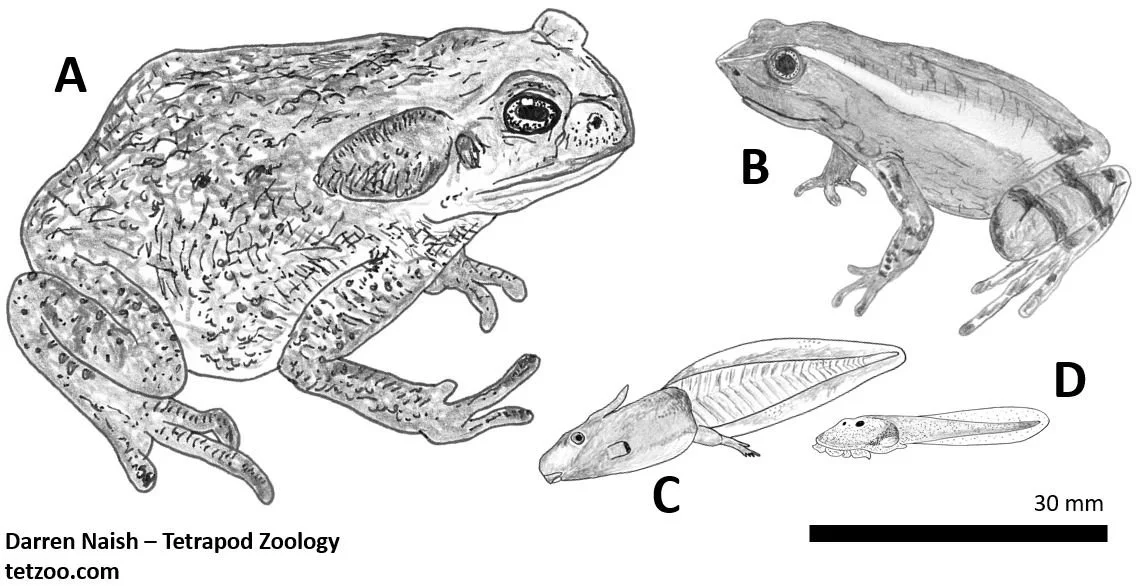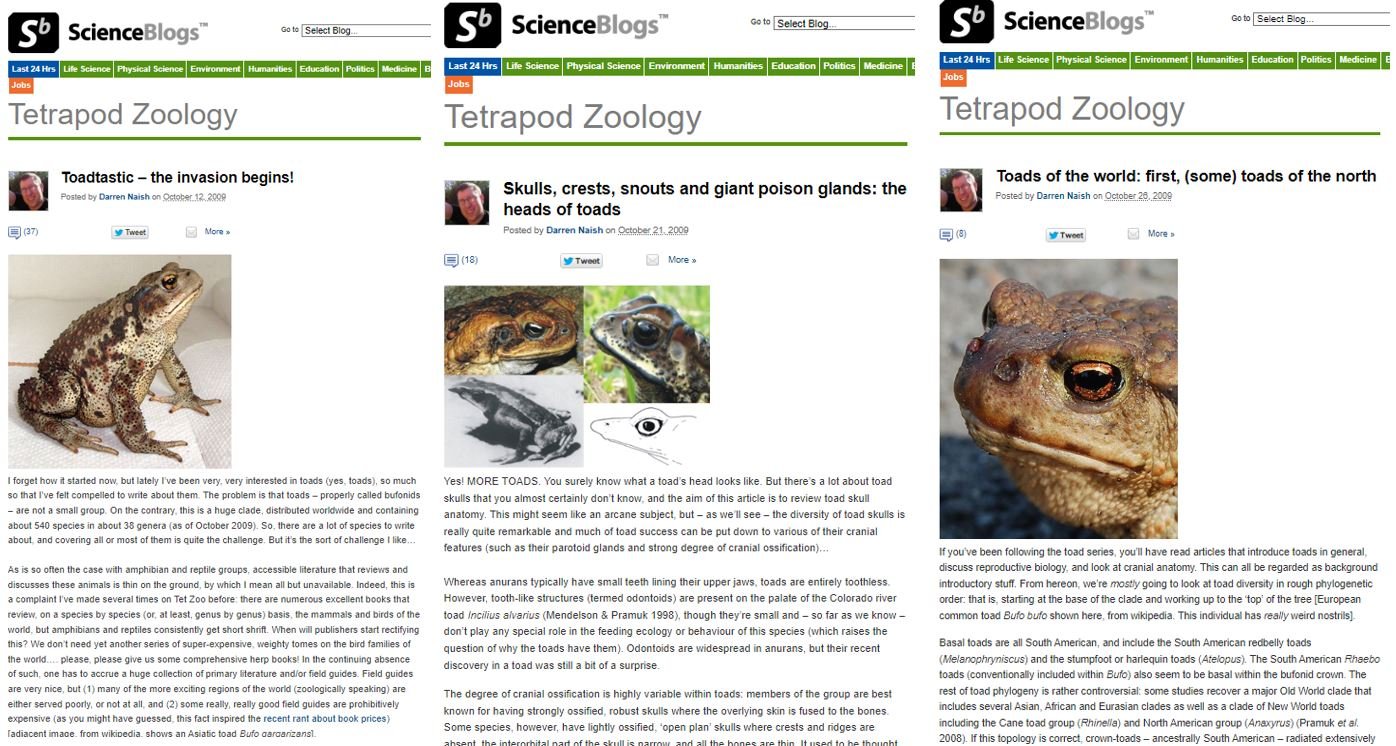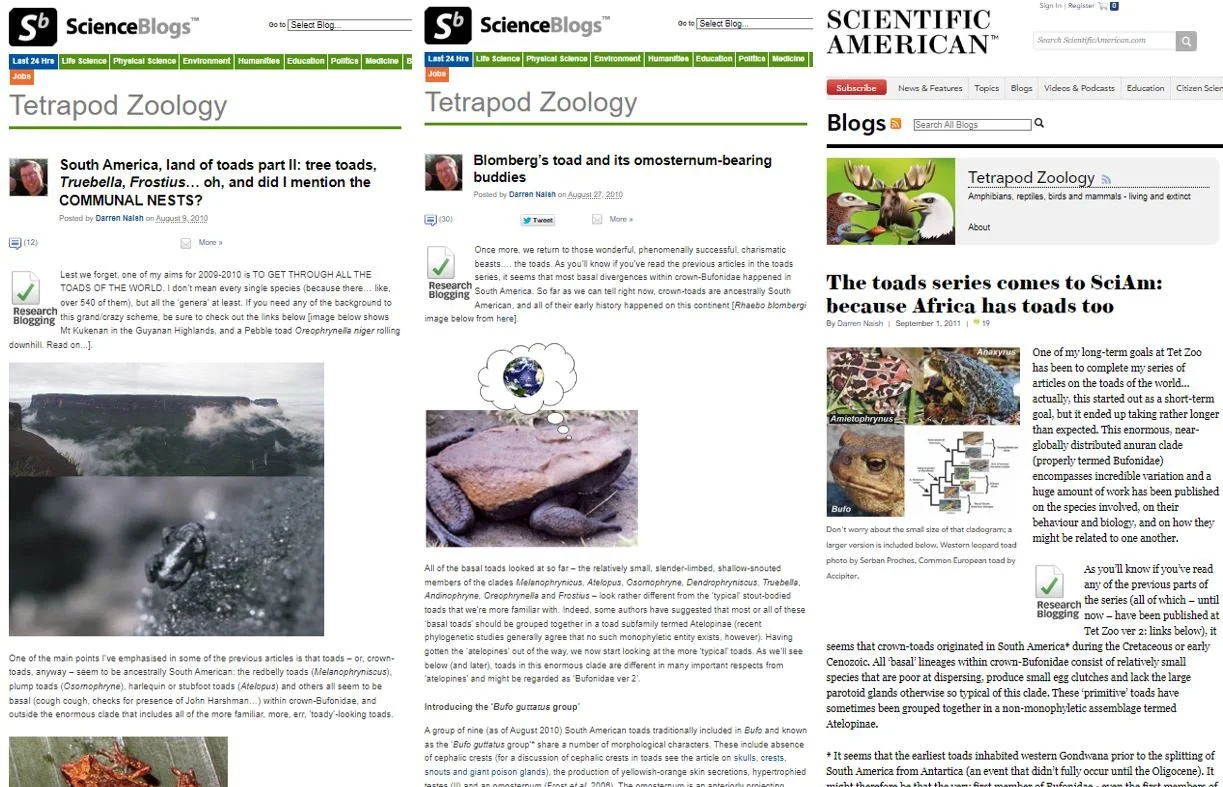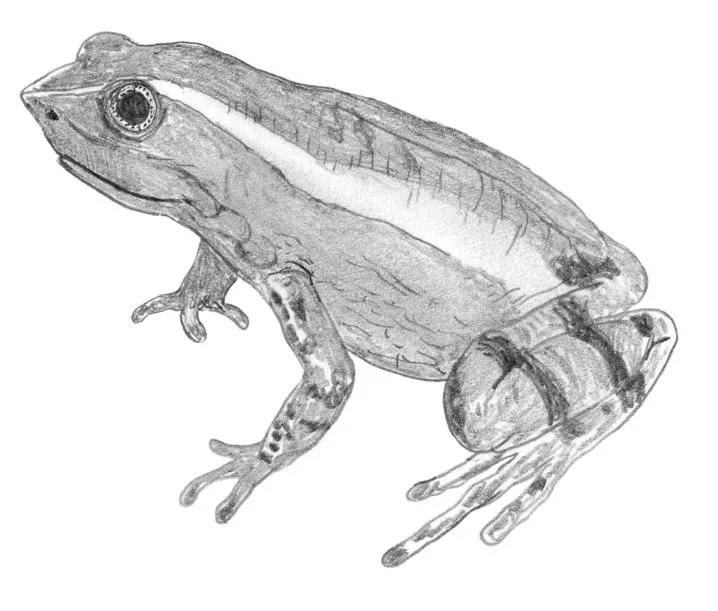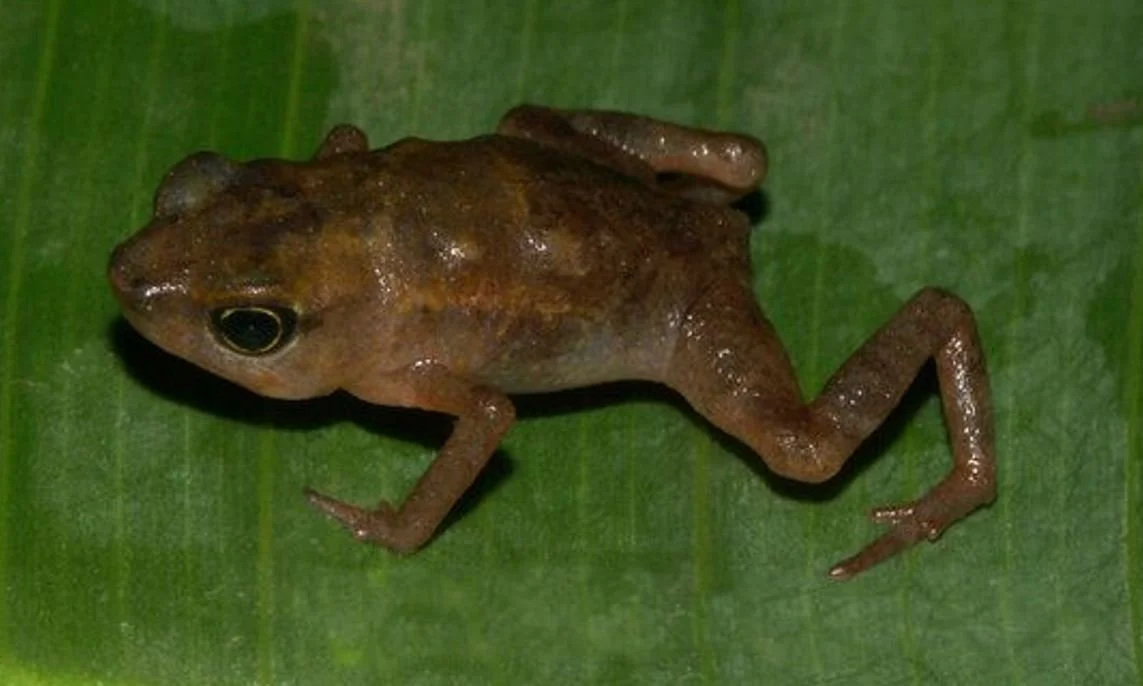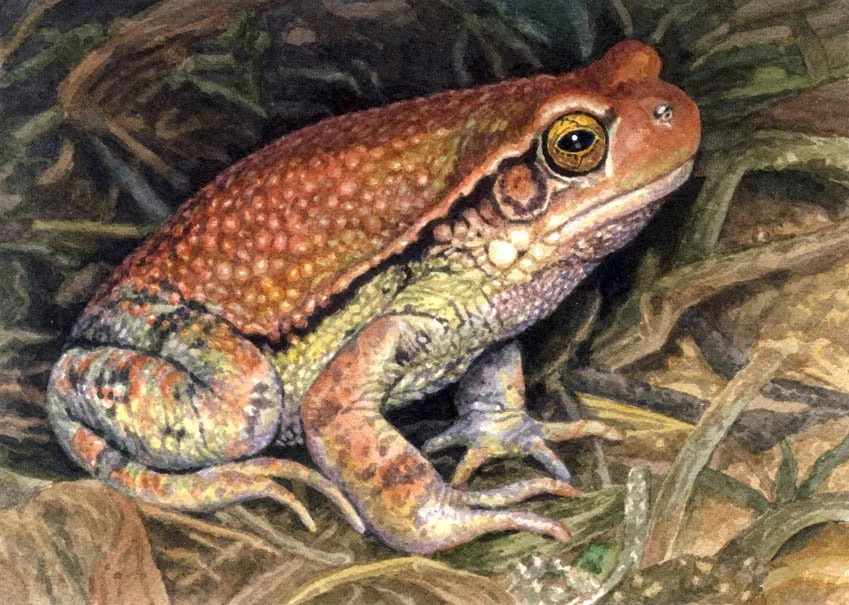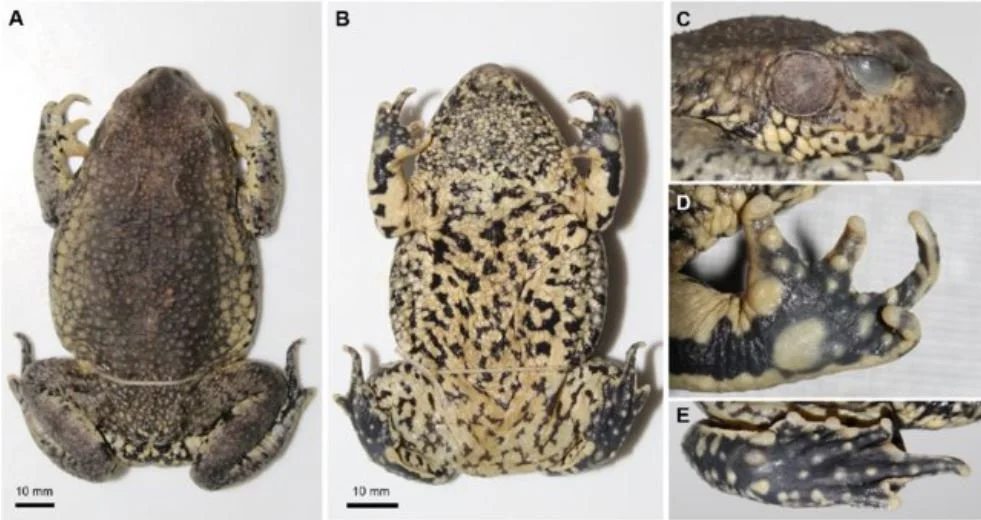Long-time readers of Tetrapod Zoology will know of my long-term plans to complete a series of articles that cover the TOADS OF THE WORLD, the first part of which was published in 2009….
Caption: a montage of animals relevant to this article. (A) a typical Bufo toad, purely for scale-related reasons; (B) Merten's smalltongue toad Werneria mertensiana, one of the species discussed in this article; (C) tadpole of a red-back toad (Schismaderma); (D) even stranger tadpole of Werneria. Images: Darren Naish.
Various complications require that this series has never been finished, and that long gaps in its publication exist. None of this is helped by the fact that Tetrapod Zoology has (by necessity, not design) moved sites four times now, a consequence being that any long-running series is now spread across three of those four different versions of the blog, this in turn meaning that some of its constituent parts can only be observed intact at wayback machine*.
* For those who don’t know, the collapse of ScienceBlogs (where Tet Zoo ver 2 is hosted) and the lack of interest at Scientific American Blogs (where Tet Zoo ver 3 is hosted) resulted in the Tet Zoo articles hosted there being reformatted and ruined, mostly through the removal of images (and comments). This presumably happened to all blogs hosted at those sites over the same timeframe.
Caption: the montages above show – just in case you don’t know – how much toad-related progress has been made at Tet Zoo over the years (specifically, between 2009 and 2014). See the bottom of this article for links to these articles and others.
Every so often, I aim to pick up where the series last left off and continue, and that’s something I aim to do this year. But in an effort to work out where we left off, and to migrate material here to ver 4 where things can be salvaged, I’m going to start by republishing the most recently published article in the series… which isn’t ‘recent’ at all, since it was published in the long-ago time of 2014. Here it is, with updates and new citations added where necessary…
In the most recent articles in the series – they were published way back in September and November 2011 (see below for links) – we looked at toads that have been identified by some as belonging to an endemic African clade. Several other lineages discussed in the same part of the series aren’t necessarily part of the same clade, but do belong to the same general region of the cladogram (Van Bocxlaer et al. 2010, Pyron & Wiens 2011).
Caption: highly simplified phylogeny for Bufonidae with some of the main evolutionary and biogeographical events marked at appropriate places. Based predominantly on Van Bocxlaer et al. (2010). Atelopus by Giovanni Alberto Chaves Portilla CC BY-SA-2.5; Rhaebo by Brian Gratwicke CC-BY-SA-2.0; Anaxyrus by LA Dawson CC BY-SA 2.5; Rhinella by Froggydarb CC BY-SA-3.0; Mertensophryne by Vladimir Dinets, used with permission; Bufo s. s. by Kruczy89 CC BY-SA 3.0; Bufotes by Richard Bartz CC BY-SA 3.0; Ansonia by Thomas Brown CC BY-SA 2.0; Duttaphrynus by L. Shyamal CC BY-SA 2.5.
Nectophryne, Werneria and Wolterstorffina. The African tree toads of the genus Nectophryne (the name ‘African tree toads’ is also used for species in the genus Nectophrynoides as well) are small, poorly known rainforest toads. Hardly any information is available on them bar the fact that they lay their eggs in little shallow pools, and that the males then guard the eggs. Molecular data suggests that Nectophryne forms a clade with the smalltongue toads (Werneria) and the Wolterstorff toads (Wolterstorffina) (Frost et al. 2006, Van Bocxlaer et al. 2010, Pyron & Wiens 2011), all of which mostly occur in western Africa. If these small toads really do form a clade, they apparently represent an endemic African radiation, and the fact that they seem to have diverged ‘early on’ within Bufonidae lends additional support to the idea of a Gondwanan origin for toads as a whole.
Caption: Bate’s tree toad Nectophryne batesii, one of the two species in the genus. It has been reported across a relatively large part of the African tropics, from Nigeria and Cameroon in the west to Central African Republic in the east and Democratic Republic of the Congo and Gabon in the south. This distribution might say something about geological antiquity, buuut might not. Image: Bernard Dupont, CC BY-SA 4.0 (original here).
Caption: Merten's smalltongue toad Werneria mertensiana. These are mid-sized anurans, with SVLs of 30-50 mm. They hide in leaf litter as well as being associated with streams. Drawing by Darren Naish, based on photo by Mary E. Gartshore.
The smalltongue toads or torrent toads (Werneria) of Gabon, Cameroon and Equatorial Guinea are small (30-40 mm SVL), nocturnal toads of fast-flowing streams. Six species are currently recognised, two of which – W. iboundji and W. submontana – were named in 2004 (Rödel et al. 2004). They’re highly dependent on running water and take refuge it in when disturbed. They eat beetles and have “a dorsolateral ridge that extends from the groin to the snout” (Graybeal & Cannatella 1995, p. 122), though this is very subtle. Parotoid glands and tympani are absent and the snout protrudes relative to the position of the mouth. Smalltongue toad tadpoles are specialised stream-dwelling animals. They’re dorsoventrally compressed with a broad head, dorsally positioned eyes and nostrils and sucker-like mouth disc.
Wolterstorff toads (also known as forest tree toads) were found by Graybeal & Cannatella (1995) to be paraphyletic with respect to a Nectophryne + Nimbaphrynoides clade, and none of the characters used to diagnose the genus appear unique. However, in at least some species the males have particularly large bony crests on their humeri, and it’s plausible that this is a synapomorphy at some level. In at least some Wolterstorff toad species (three are recognized), the tadpoles have a small ventral sucker.
Caption: Werneria tadpole in lateral view. The sucker-like mouth is fringed with soft, flap-like extensions. Illustration by Darren Naish, based on a drawing from Rödel et al. (2004). These tadpoles are around 17-24 mm long in total.
Four-digit toads. Didynamipus sjostedti, sometimes called the Four-digit toad, is a small bufonid restricted to Cameroon, Equatorial Guinea and Nigeria. It also lacks a tympanum and columella (what is it with all these toads losing their ears?) and have a reduced phalangeal and digital formula (as suggested by the name, only four toes are present). Two competing phylogenetic views have been proposed for this taxon. One idea – based on an analysis of morphological characters – is that it's part of an endemic African clade that also includes Nimbaphrynoides (the Nimba toads of Liberia, Ivory Coast and Guinea), Parker’s tree toad Laurentophryne parkeri and the Nectophryne African tree toads (Graybeal & Cannatella 1995). The other idea is that, together with the Nectophrynoides tree toads, it's close to the Asian stream toads Ansonia (Pyron & Wiens 2011). There are suggestions that this toad might exhibit direct development (that is, there’s no tadpole phase) but I don’t know if this has yet been confirmed, or otherwise.
Caption: Four-digit toad Didynamipus sjostedti, photographed in the wild by Václav Gvoždík. It’s tiny, females having an SVP of 19 mm, males 16 mm. Image CC BY-SA 2.5 (original here).
Having mentioned Parker’s tree toad: it also lacks a tympanum and columella, and in fact is like the four-digit toads in possessing only seven presacral vertebrae.
Caption: excellent illustration of Red-backed toad by Willems van der Merwe. Schismaderma toads is a bit different from the other toads discussed in this article: it’s relatively large size, granular dorsal skin texture, toxicity and large egg clutches make it part of the ‘range-expansion phenotype’ identified in toads by Van Bocxlaer et al. (2010) (for more on that concept, see the 2011 article The toads series comes to SciAm: because Africa has toads too). Image: Willems van der Merwe, used with permission.
The Red-backed toad… I mean, toads! Finally, for now, we look at the Red toad or Red-backed toad Schismaderma carens. This is a highly distinctive African toad, conventionally included in Bufo and regarded as representing the ‘Bufo carens group’. Its inclusion within Bufo sensu lato was always peculiar, as it lacks parotoid glands. The larvae are distinctive in possessing a U-shaped fold on the dorsal surface (Graybeal & Cannatella 1995) and adults are also easily identified thanks to their reddish backs (the underside is creamy or light grey), prominent lateral skin fold, and twin dark spots on the back.
Until very recently, Schismaderma was monotypic and thus ‘Red-backed toad’ was synonymous with S. carens. However, a second species was named in 2021: the Angolan red toad S. branchi, named for late herpetologist Bill Branch (1946-2018). It’s smaller than S. carens, with less prominent, less numerous palmar tubercles and bolder ventral patterning. Some individuals are fully as red as some individuals of S. carens, but S. branchi always lacks the prominent dark spots on the back and the black lateral stripes typical of the former species (Baptista et al. 2021).
Caption: Red-backed toad tadpole in lateral view. These tadpoles are relatively large, reaching 35 mm. They’re social and move about in tightly packed ball-shaped shoals. Illustration by Darren Naish, based on illustration in Channing (2001).
The affinities of Schismaderma have been contentious. Pramuk (2006) found it to belong to a clade that also included the African 20-chromosome toads (Amietophrynus) and to be the sister-taxon to the Asian ‘Bufo melanostictus group’ (named Duttaphrynus by Frost et al. (2006)). Frost et al. (2006) also recovered Schismaderma and Duttaphrynus as close relatives, but found Bufotes (Old World green toads) and Peltophryne to form a clade with Duttaphrynus and Schismaderma too. Van Bocxlaer et al. (2009, 2010) found Schismaderma to be the sister-taxon to a Churamiti + Nectophrynoides clade while Pyron & Wiens (2011) found it to be the sister-taxon to the Old World green toads.
Caption: holotype male specimen of Schismaderma branchi Baptista et al., 2021. The species is so far unique to the Luando River sub-basin, bordering the Cuanza-Congo watershed, of Angola, but there are suspicions that its distribution might be broader. Image: Baptista et al. (2021).
And with that... we’re done with another segment of the toad family tree. Well, I couldn't finish the section on the Ethiopian toads because I have yet to find any goddam pictures than I can use. On that note, more on toads at some point in the future, oh yes.
For previous articles in the Tet Zoo toads series see...
Toadtastic - the invasion begins!, October 2009
Bidder's organ and the holy quest for synapomorphies, October 2009
Our sex lives in words and pictures (or, On the reproductive biology of the Bufonidae), October 2009
Skulls, crests, snouts and giant poison glands: the heads of toads, October 2009
Toads of the world: first, (some) toads of the north, October 2009
The Natterjack, its life and times, October 2009
The resurrection of Anaxyrus, November 2009
South America, land of toads, part I: harlequins, redbellies and plump toads, January 2010
South America, land of toads part II: tree toads, Truebella, Frostius... oh, and did I mention the COMMUNAL NESTS?, August 2010
Blomberg’s toad and its omosternum-bearing buddies, August 2010
The toads series comes to SciAm: because Africa has toads too, September 2011
20-chromosome toads, September 2011
And for articles on other hyloid anurans, see…
Green-boned glass frogs, monkey frogs, toothless toads, November 2007
Glassfrogs: translucent skin, green bones, arm spines, January 2013
Everybody loves glassfrogs, February 2013
Gladiatorial glassfrogs, redux, January 2015
Frogs you may not have heard of: Brazil’s Cycloramphus ‘button frogs’, January 2015
It's the Helmeted water toad… this time, with information!, January 2015
The Terrible Leaf Walker Frog, March 2017
What, If Anything, Is A Strabomantid?, January 2024
Refs - -
Baptista, N. L., Pinto, P. V., Keates, C., Edwards, S., Rödel, M.-O. & Conradie, W. 2021. A new species of red toad, Schismaderma Smith, 1849 (Anura: Bufonidae), from central Angola. Zootaxa 5081, 301-332.
Channing, A. 2001. Amphibians of Central and Southern Africa. Cornell University Press, Ithaca & London.
Frost, D. R., Grant, T., Faivovich, J., Bain, R. H., Haas, A., Haddad, C. F. B., De Sá, R. O., Channing, A., Wilkinson, M., Donnellan, S. C., Raxworthy, C. J., Campbell, J. A., Blotto, B. L., Moler, P., Drewes, R. C., Nussbaum, R. A., Lynch, J. D., Green, D. M. & Wheeler, W. C. 2006. The amphibian tree of life. Bulletin of the American Museum of Natural History 297, 1-370.
Graybeal, A. & Cannatella, D. C. 1995. A new taxon of Bufonidae from Peru, with descriptions of two new species and a review of the phylogenetic status of supraspecific bufonid taxa. Herpetologica 51, 105-131.
Pramuk, J. B. 2006. Phylogeny of South American Bufo (Anura: Bufonidae) inferred from combined evidence. Zoological Journal of the Linnean Society 146, 407-452.
Pyron, R. A. & Wiens, J. J. 2011. A large-scale phylogeny of Amphibia including over 2,800 species, and a revised classification of extant frogs, salamanders, and caecilians. Molecular Phylogenetics and Evolution 61, 543-583.
Rödel, M.-O., Schmitz, A., Pauwels, O. S. G. & Böhme, W. 2004. Revision of the genus Werneria Poche, 1903, including the descriptions of two new species from Cameroon and Gabon (Amphibia: Anura: Bufonidae). Zootaxa 720, 1-28.
Van Bocxlaer, I., Loader, S. P., Roelants, K., Biju, S. D., Menegon, M. & Bossuyt, F. 2010. Gradual adaptation toward a range-expansion phenotype initiated the global radiation of toads. Science 327, 679-662.

